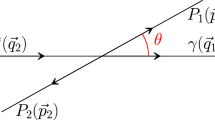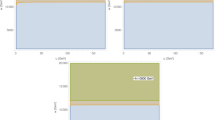Summary
The possibility that the unitarity sum for the absorptive part of the\(K_L \to \mu \bar \mu \) amplitude receives contribution in aCP-invariant manner from an on-mass-shell intermediate state involving a yet undetected light neutral boson (we call itx 0) is considered. It is suggested that the most relevant intermediate state is thex 0λ state withx 0 having spin-parity 1−. It is pointed out that the existence of such a particle, if it is not already excluded by present experiments, can be tested unambiguously and relatively easily by two experiments:a) the measurement of the rate of the KL→x 0+λ decay (thex 0 may be looked for easily via its decays to (e−e+) and (μ−μ+) systems), andb) the production of thex 0 by low-invariant-mass (e−e+) colliding-beam experiments. It is noted that thex 0, if it exists, receives a «natural» interpretation only in framework of hadron symmetries higher than the familiarSU 3-group. The production ofx 0 by a host of production and decay processes is discussed subject to such an interpretation.
Riassunto
Si considera la possibilità che alla parte assorbitiva dell'ampiezza\(K_L \to \mu \bar \mu \) contribuisca per unitarietà, in modoCP invariante, uno stato intermedio sullo strato delle masse contenente un bosone leggero neutro tuttora non rivelato (chiamatoxP0). Si suggerisce che lo stato intermedio più rilevante sia lo stato (x 0λ) con spin e parità delx 01−. Si sottolinea che l'esistenza di tale particella, se non è già esclusa dagli esperimenti attuali, può essere provocata senza ambiguità e con relativa facilità con due esperimenti:a) la misura del rapporto del decadimenti KL→x 0+λ (ilx 0 può essere cercato facilmente per mezzo dei suo decadimenti in sistemi (e−e+) ed (μ−μ+)), eb) la produzione dix 0, in esperimenti con fasci incrociati di e− e e+ di bassa energia. Si nota che ilx 0, se esiste, riceve una interpretazione «naturale» solo nell'ambito di simmetrie adroniche più elevate del familiare gruppoSU 3. La produzione dix 0 da un gran numero di processi di produzione e di decadimento è discussa nell'ambito dei tale interpretazione.
Резюме
Рассматриваается возможность того, что унитарная сумма для абсорбционной части амплитуды\(K_L \to \mu \bar \mu \) получает вкладCP инвариантным образом от промежуточного состояния на массовой поверхности, которое включает в себя еще недектируемый негкий нейтральный бозон ( (назовем егоx 0). Предполагается, что наиболее подходящее промезуточное состояние представляет состояние (x 0λ) сx 0, который имеет спиновую четность 1−. Отмечается, что существование такой частицы, если оно уже не исключено на основе имеющихся экспериментальных данных, может быть однозначно и сравнительно легко проверено с помощью двух экспериментов:a) измерение интенсивности распада KL→x 0+λ (частицаx 0 может быть легко найдена через ее распады в системы (e−e+) и (μ−μ+)) иб) рождениеx 0. В экспериментах на (e−e+) встречных пучках. Указывается, чтоx 0, если она существует, получает «естественную» интерпретацию только в рамках адронных симметрий вьппе, чем обычная группаSU 3. Отмечается, что рождениеx 0 подчиняется такой интерпретации.
Similar content being viewed by others
References
A. R. Clark, T. Ellioff, R. C. Field, H. J. Frisch, R. P. Johnson, L. T. Kerth andW. A. Wenzel:Phys. Rev. Lett.,26, 1667 (1971).
C. Quigg andJ. D. Jackson: UCRL Report 18487 (1968), unpublished;L. M. Sehgal:Nuovo Cimento,45 A, 785 (1966);Phys. Rev.,183, 1511 (1969).
B. R. Martin, E. de Rafael andJ. Smith:Phys. Rev. D,2, 179 (1970);M. K. Gaillard:Phys. Lett.,35 B, 431 (1971).
B. R. Martin, E. de Rafael andJ. Smith:Phys. Rev. D,2, 179 (1970);N. Christ andT. D. Lee:Phys. Rev. D,4, 209 (1971);M. Pratap, J. Smith andZ. Uy: Stony Brook preprint (1971);S. L. Adler, G. R. Farrar andS. B. Treiman: NAL preprint THY22 (1971).
R. C. Thatcher, A. Abashian, R. J. Abrams, D. W. Carpenter, R. E. Mischke, B. M. K. Nefkens, J. H. Smith, L. J. Verhey andA. Wattenberg:Phys. Rev.,174, 1674 (1968).
See, for example:Particle Data Group, A. Rittenberg, A. Barbaro-Galtieri, T. Lasinski, A. H. Rosenfeld, T. G. Trippe, M. Roos, C. Bricman, P. Söding, N. Barash-Schmidt andC. G. Wohl:Rev. Mod. Phys.,43, No. 2, Part II (1971).
N. Christ andT. D. Lee:Phys. Rev. D,4, 209 (1971).
See:B. Lautrup, A. Peterman andE. de Rafael: CERN preprint TH. 1388 (1971), to be published inPhys. Rep., for an excellent review on the theoretical and experimental situation as well as the relevant references.
(see Sect. 7 of ref. (15)) See:B. Lautrup, A. Peterman andE. de Rafael: CERN preprint TH. 1388 (1971), to be published inPhys. Rep., for an excellent review on the theoretical and experimental situation as well as the relevant references.
C. A. Ramm:Nature Phys. Sci.,230, 145 (1971);R. P. Johnson et al.: Lawrence Radiation Laboratory preprint LBL-4 (1971);W. A. Wenzel: private communication.
The measurements ofR. P. Johnson et al., ref. (25).
T. Dass, V. S. Mathur andS. Okubo:Phys. Rev. Lett.,19, 470 (1967).
The word «charm» was first introduced in connection withSU 4 symmetry byJ. D. Bjorken andS. L. Glashow:Phys. Lett.,11, 255 (1964).
For our purposes, we may use the dispersion approach as well as the field current identity approach, ref. (32), interchangeably for the origin of the coefficientem 2η /9 η.
M. Y. Han andY. Nambu:Phys. Rev.,139, B 1006 (1964);A. Tavkhelidze:High-Energy Physics and Elementary Particles (Trieste, 1965), p. 763;N. Cabibbo, L. Maiani andG. Preparata:Phys. Lett.,25 B, 132 (1967). They propose the socalled SUB model which isdistinct in many respects from the Han-Nambu model (see:J. C. Pati andC. H. Woo:Phys. Rev. D,3, 1173 (1971). In the present paper we follow the SUB model; similar considerations can be presented in the Han-Nambu model also.
N. M. Kroll, T. D. Lee andB. Zumino:Phys. Rev.,157, 1376 (1967).
SeeJ. C. Pati andC. H. Woo:Phys. Rev. D,3, 1173 (1971) for an analogous discussion.
Y. Ne'eman:Phys. Rev.,134, B 1355 (1964).
S. Buniatov et al., CERN preprint (1967);E. Zavattini: private communication.
R. Armenteros, P. Baillon, C. Bricman, M. Ferro-Luzzi, E. Pagiola, J. O. Petersen, D. E. Plane, N. Schmitz, E. Burkhardt, H. Filthuth, E. Kluge, H. Oberlack, R. R. Ross, R. Barloutaud, P. Granet, J. Meyer, J. P. Porte andJ. Prevost:Nucl. Phys.,21 B, 15 (1970).
R. Anderson, D. Gustavson, J. Johnson, D. Ritson, B. H. Wiik, W. G. Jones, D. Kreinick, F. Murphy andR. Weinstein:Phys. Rev. D,1, 27 (1970).
J. G. Asbury, W. K. Bertram, U. Becker, P. Joos, M. Rohde, A. J. S. Smith, S. Friedlander, C. Jordan andC. C. Ting:Phys. Rev. Lett.,18, 65 (1967);H. Albensleben, U. Becker, W. K. Bertram, M. Binkley, K. Cohen, C. L. Jordan, T. M. Knasel, R. Marshall, D. J. Quinn, M. Rohde, G. H. Sanders andS. C. C. Ting:Phys. Rev. Lett.,21, 1501 (1968). See also:P. J. Biggs, D. W. Braben, R. W. Clifft, E. Gabathuler, P. Kitching andR. E. Rand:Phys. Rev. Lett.,23, 927 (1969).
A. Wehmann, E. Engels Jr.,L. N. Hand, C. M. Hoffman, P. G. Innocenti, R. Wilson, W. A. Blanpied, D. J. Drickey andD. G. Stairs:Phys. Rev. Lett.,17, 1113 (1966);B. D. Hyams, W. Koch, D. Pellett, D. Potter, L. von Lindern, E. Lorenz, G. Lütjens, U. Stierlin andP. Weilhammer:Phys. Lett.,24 B, 634 (1967).
B. D. Hyams, W. Koch, D. C. Potter, L. von Lindern, E. Lorenz, G. Lütjens, U. Stierlin andP. Weilhammer:Phys. Lett.,29 B, 128 (1969). Also,B. D. Hyams: private communication.
M. Basile, D. Bollini, P. Dalpiaz, P. L. Frabetti, T. Massam, F. Navach, F. L. Navarria, M. A. Schneegans andA. Zichichi: CERN preprint (1971), presented byF. L. Navarria: at theInternational Conference on Meson Resonances and Related Electromagnetic Phenomena (Bologna, 1971);E. H. Harvey, E. Marquit, E. A. Peterson, T. G. Rhoades, H. Romer, K. Ruddick andJ. K. Randolph:Phys. Rev. Lett.,27, 885 (1971).
Author information
Authors and Affiliations
Additional information
Перебедено редакцуей.
Rights and permissions
About this article
Cite this article
Alles, W., Pati, J.C. Tests for a possible class ofCP invariant solutions to the\(K_L \to \mu \bar \mu \) problem. Nuov Cim A 10, 325–342 (1972). https://doi.org/10.1007/BF02895768
Received:
Published:
Issue Date:
DOI: https://doi.org/10.1007/BF02895768




